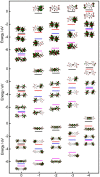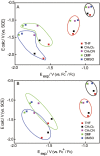Bridge- and solvent-mediated intramolecular electronic communications in ubiquinone-based biomolecular wires
- PMID: 25996306
- PMCID: PMC4440530
- DOI: 10.1038/srep10352
Bridge- and solvent-mediated intramolecular electronic communications in ubiquinone-based biomolecular wires
Abstract
Intramolecular electronic communications of molecular wires play a crucial role for developing molecular devices. In the present work, we describe different degrees of intramolecular electronic communications in the redox processes of three ubiquinone-based biomolecular wires (Bis-CoQ0s) evaluated by electrochemistry and Density Functional Theory (DFT) methods in different solvents. We found that the bridges linkers have a significant effect on the electronic communications between the two peripheral ubiquinone moieties and solvents effects are limited and mostly depend on the nature of solvents. The DFT calculations for the first time indicate the intensity of the electronic communications during the redox processes rely on the molecular orbital elements VL for electron transfer (half of the energy splitting of the LUMO and LUMO+1), which is could be affected by the bridges linkers. The DFT calculations also demonstrates the effect of solvents on the latter two-electron transfer of Bis-CoQ0s is more significant than the former two electrons transfer as the observed electrochemical behaviors of three Bis-CoQ0s. In addition, the electrochemistry and theoretical calculations reveal the intramolecular electronic communications vary in the four-electron redox processes of three Bis-CoQ0s.
Conflict of interest statement
The authors declare no competing financial interests.
Figures





Similar articles
-
A systematic theoretical study of the electronic structures of porphyrin dimers: DFT and TD-DFT calculations on diporphyrins linked by ethane, ethene, ethyne, imine, and azo bridges.Phys Chem Chem Phys. 2013 Nov 21;15(43):18951-64. doi: 10.1039/c3cp53396d. Phys Chem Chem Phys. 2013. PMID: 24097279
-
Elaborately Tuning Intramolecular Electron Transfer Through Varying Oligoacene Linkers in the Bis(diarylamino) Systems.Sci Rep. 2016 Nov 2;6:36310. doi: 10.1038/srep36310. Sci Rep. 2016. PMID: 27805023 Free PMC article.
-
Quantum simulation of solution phase intramolecular electron transfer rates in betaine-30.J Phys Chem A. 2006 Oct 5;110(39):11223-9. doi: 10.1021/jp063222d. J Phys Chem A. 2006. PMID: 17004730
-
Bis-coenzyme q(0) : synthesis, characteristics, and application.Chem Asian J. 2011 Apr 4;6(4):1064-73. doi: 10.1002/asia.201000477. Epub 2010 Nov 16. Chem Asian J. 2011. PMID: 21433296
-
Characterization of three members of the electron-transfer series [Fe(pda)2]n (n=2-, 1-, 0) by spectroscopy and density functional theoretical calculations [pda=redox non-innocent derivatives of N,N'-bis(pentafluorophenyl)-o-phenylenediamide(2-, 1.-, 0)].Chemistry. 2008;14(25):7608-22. doi: 10.1002/chem.200800546. Chemistry. 2008. PMID: 18601237
Cited by
-
Molecular Compasses for Modulating Electronic Communication in Pillar[5]quinone.J Am Chem Soc. 2025 Apr 16;147(15):12425-12437. doi: 10.1021/jacs.4c12280. Epub 2025 Apr 5. J Am Chem Soc. 2025. PMID: 40186618 Free PMC article.
References
-
- Zhou Q. & Swager T. M. Fluorescent Chemosensors Based on Energy Migration in Conjugated Polymers: The Molecular Wire Approach to Increased Sensitivity. J. Am. Chem. Soc. 117, 12593–12602 (1995).
-
- Weiss E. A. et al. Making a Molecular Wire: Charge and Spin Transport through para-Phenylene Oligomers. J. Am. Chem. Soc. 126, 5577–5584 (2004). - PubMed
-
- Nitzan A. & Ratner M. A. Electron Transport in Molecular Wire Junctions. Science 300, 1384–1389 (2003). - PubMed
-
- Bae J. H., Lim Y. R., Jung W., Silbey R. J. & Sung J. Practical Model for Imperfect Conductometric Molecular Wire Sensors. Anal. Chem. 81, 578–583 (2008). - PubMed
-
- Ozawa H. et al. A photo-responsive molecular wire composed of a porphyrin polymer and a fullerene derivative. J. Mater. Chem. 19, 8307–8313 (2009).
Publication types
LinkOut - more resources
Full Text Sources
Other Literature Sources
Miscellaneous

